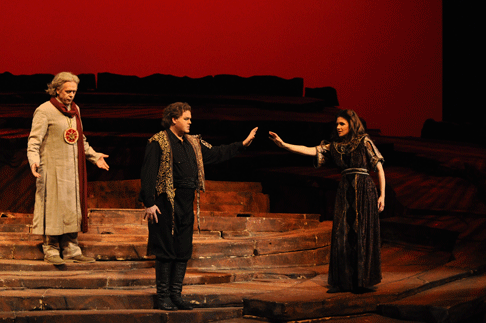Manitoba Opera’s production of this three-hour masterpiece offered a
bonus feature: a crackerjack cast rich with talented Manitobans working their
own special magic. Twelve out of 15 roles were filled by Manitoba singers.
The opera’s set, representing 1882 Egypt, was a stark multi-level
structure resembling stone. Creative curtain draping, props dropping from above
and a brightly lit pyramid made for efficient, if slight, scene changes.
As Tadeusz Biernacki conducted the Winnipeg Symphony Orchestra through the
overture, we were treated to some inventive effects — characters
silhouetted high against a red sky, watching as an Anglo-Egyptian War battle
raged below making explosions of light. Bill Williams’ lighting
introduced the story before a single note was sung.
We first see American lyric tenor Bruce Sledge (Tamino), struggling to
escape a huge, Chinese dragon-like serpent, with billowy cloth body, gigantic
googly-eyed head with fangs. He was saved by three hilariously preening ladies,
played to the hilt by sopranos Sarah Halmarson and Naomi Forman and
smoky-voiced mezzo Marcia Whitehead. Coiffed in multi-coloured streaks, they
fawned competitively over the collapsed Tamino, making clever (and suggestive)
choreographic use of the crooked poles they carried.
Sledge has a true hero’s voice and demeanour. In “Dies Bildnis
ist bezaurbernd schˆn,” he poured his heart into his singing, flowing
phrases imbued with passion. He also did a mean representation of
flute-playing, making it quite believable.
One of opera’s all-time favourite characters, bird-catcher Papageno
was played by baritone Hugh Russell. Dressed in feathers and rags, he was
delightfully animated, his easy, pleasing voice setting just the right tone for
this amiable role. Russell is the ideal Papageno, with great comic ability and
superb timing.
While the opera was sung in German, all dialogue (by Schikaneder) was in
English, so the audience could laugh along with Papageno when he spouted such
gems as “all this stress is making me moult out of season” and
claimed that the wine was giving him “acid reflux.” Director
Michael Cavanagh went to town with the dialogue, giving us plenty of
chuckles.
 Phillip Ens (Sarastro), Bruce Sledge (Tamino), and Andriana Chuchman (Pamina). [Photo: R. Tinker]
Phillip Ens (Sarastro), Bruce Sledge (Tamino), and Andriana Chuchman (Pamina). [Photo: R. Tinker]
Papageno’s better half, Papagena, was the delightful Lara Ciekewicz.
She was positively bubbly in this small role. Their “Pa-pa-pa-gena!
Pa-pa-pageno!” was lively and adorable.
Speaking of adorable, who couldn’t love the three genii with their
bushy white hair and angelic voices? Bravo to Carson Milberg, Anton Dahl
Sokalski and Torbjˆrn Thomson.
As the infamous Queen of the Night, American coloratura Julia Kogan made
quite the entrance, floating down from the sky on a fantastical winged camel.
Dressed in a magnificent gown, she was ghostly pale — but her fine voice
was anything but. Assertive and commanding, she ordered Tamino to rescue her
daughter Pamina. But in later scenes, Kogan’s dialogue was almost
inaudible upstage. She made a valiant effort in the devilishly difficult
“Der Hˆle Rachekocht in meinem Herzen,” reaching for the highest
notes with obvious exertion.
Winnipeg soprano Andriana Chuchman’s Pamina was radiantly
princess-like, with an appealing dose of youthful exuberance. Chuchman is a
natural performer, with a mature, substantial voice that carries exceedingly
well. The famous lament, “Ach, ich f¸hl’s, es ist
verschwunden” was masterfully crafted, round notes oozing heartbreak.
Phillip Ens’ resonant bass made the ultimate High Priest Sarastro,
steady and noble. The depth and pomp of his performance made every hair stand
on end. His regal robes were elegant and refined.
His slave Monostatos, played by the athletic Michel Corbeil, appeared
tattooed from the top of his bald head to his toes. His flexible tenor voice
sneered through his lines, making him the villain we loved to hate.
Gregory Atkinson was perfectly cast as an authority figure (High Priest),
his deep voice richly resplendent. PJ Buchan’s (Priest) glorious tenor
voice sounds better on every outing.
The chorus rounded out the production nicely, always well balanced and
supportive. Kudos go to the orchestra, in particular for the many solos by
flute and glockenspiel. There would be no Magic Flute without them.
This was a first-rate production in every way.
Gwenda Nemerofsky
image=
image_description=
product=yes
product_title=W. A. Mozart: The Magic Flute
product_by=Manitoba Opera, Centennial Concert Hall, April 9, 2011
product_id=